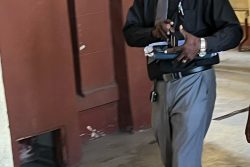With a commitment from Demerara Distillers Limited (DDL) to a scheduled overhaul of its plants and works currently ongoing, the Environmental Protection Agen-cy (EPA) believes the company is setting an environmental oversight standard for all to follow.
“DDL is a good example. They have begun the implementation of a new department just to manage environment and are working on schedule on the plants,” EPA Executive Director Dr. Vincent Adams told Stabroek News on Sunday when contacted.
“They have complied [with] the standards set and are working with us. It makes us feel better because the things we have done so far have seen things in the industry performing better,” he added
This newspaper has tried reaching the rum and beverages company to get an update on works completed but has not been able to.
In the wake of complaints by Great Diamond residents that waste from the company’s biomethanation plant had been affecting them, coupled with the EPA’s findings that some of the company’s operations did not have the necessary permits, the company in July began the process to establish an environmental oversight department.
With a Canadian consultancy firm and other personnel hired to assist with the process, it was Adams who had made the announcement about the upgrade.
“The EPA has to absorb some of that blame— and I will explain— but the company decided they will establish an environmental management department to focus on, well, environmental issues. They brought in a Canadian consultant to help with this process, they are looking at the best available technology and best qualified personnel to deal with these issues,” he added.
Bemoaning years of fetid waters in their yards and on the roadways from the biomethanation plant, the residents filed a complaint with the EPA. As a result, the EPA ordered that the biomethanation plant cease operation.
The suspension of operations was followed by an EPA team, led by Adams, visiting the company’s operational site at Diamond, as well as the surrounding community, to gain a firsthand understanding of the situation. It was during this visit that environmental infringements were observed and the EPA sought a complete review of all operations.
It was from that review that it was found that the company did not have the necessary permits for about 10 of its operations.
“As I said, the company had 10 operations which required 10 permits but they did not have these and were operating anyway and they cannot be wholly blamed. Putting it in context, most of the company’s operations were there even before the EPA’s existence. They had applied to the EPA for some permits—and be clear that all this was before I started here last year—and they never got replies from the EPA. So although they made applications and were not granted, they went ahead and operated. Yes, I accept that we were at fault in some ways,” Adams had explained.
“We found that there was effluent from these 10 facilities…and for example, they were washing some waste tanks and then dumping that directly into the Demerara River. They also went ahead, built some stuff that needed permits and things like that…,” he added.
He said that when DDL was told of some of the observations and findings of the EPA’s review, it was “very responsive and very cooperative” and they proposed the environmental department.
“Things now would be far better because they never had an environmental department. They were discharging waste which wasn’t treated into the river …that has changed now so it is a very strict standard. Everything is working out for the better. You see, so not only the biomethanation plant but that one aspect triggered an entire review and they are really upgrading those. We will have a better operating plant and DDL is now forming the model of how facilities are expected to operate,” he said.








